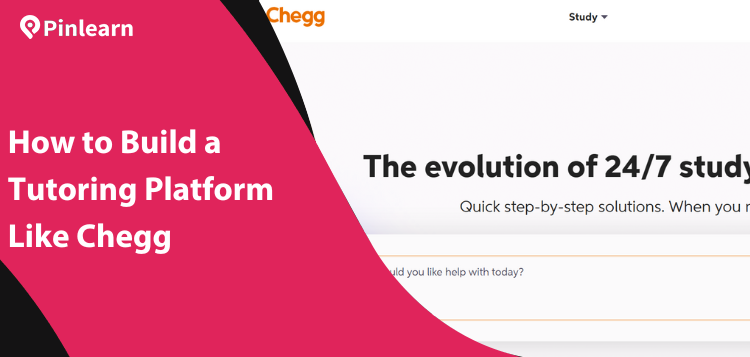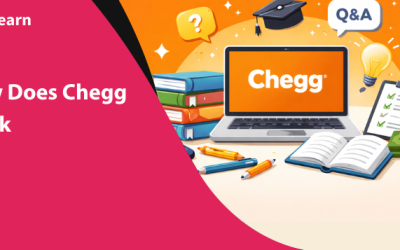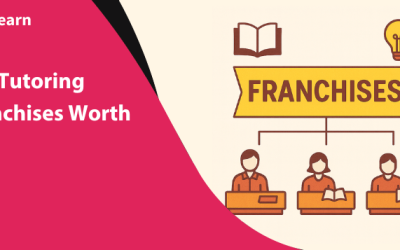How to Build a Tutoring Platform Like Chegg?
Online tutoring is making education more accessible, personalized, and efficient more than ever. With advancements in AI and technology, there are better learning opportunities for students.
That said, Chegg has been an industry leader for 11 years in the tutoring space. While other tutoring platforms wielded their space with 30-minute Zoom sessions, Chegg adopted a more subtle approach. The platform realized the need for quick and convenient help and scaled its business on this modern approach.
If you’re an educator taking a leap with tutoring business, this blog is the ultimate guide. You will gain key insights and strategies on how to create a tutoring platform like Chegg.
So, are you ready to be the next generation of tutoring platforms shaping the industry?
Why Build a Tutoring Platform like Chegg?
Now, Chegg’s impressive success might have led to this profitable business idea. But, you are wondering, is tutoring business profitable?
If so, here are the key reasons to build a Chegg-like tutoring platform:
-
Growing Market Demand
Online tutoring is a $10.42 billion industry in 2024 and is expected to grow in the coming years. Increasing demand for personalized learning, upskilling and the need for on-demand solutions by professionals has contributed to its growth.
-
Revenue Opportunity
Platforms like Chegg earn from diverse revenue streams, including subscriptions, commissions, advertising, and textbook rentals. This significantly increases the platform’s revenue and business growth.
-
Student Support
Whether it’s 1-on-1 live sessions, Q&A forums, or learning materials, tutoring platforms continuously help to bridge the learning gap.
-
Build Domain Authority
With an extensive hub of expert Q&A and access to millions of textbooks and learning resources, you can build a learning ecosystem. This way, you establish your authority as a go-to platform for guidance and student support.
How Does Chegg Work?
Chegg is a popular tutoring company offering a range of educational services from homework help to tutoring and learning resources. The popular tutoring platform operates on a mix of on-demand tutoring services and a subscription model. Additionally, the platform also provides academic support tools.
For Students
Here are the essential segments of the Chegg platform:
- Chegg Study – Student subscription pack including homework solutions, quiz & exam help, plagiarism detection, proofreading & math help. The subscription pack costs $15- $20 per month.
- Chegg Tutors – Students can book tutoring sessions with their preferred tutors and connect with them instantly.
- Textbook Rentals – Students can buy, rent or sell physical textbooks at competitive prices with flexible rental options.
- Chegg Writing & Math Solver – Its value-added services include essay writing, plagiarism & grammar checker, citation generator, and math problem solver.
For Tutors
Educators & experts can create profiles and post expert answers for homework help or even offer 1:1 tutoring services. They earn money either on a commission basis or per question/answer basis.
Students can use the extensive search & filtering to find the right tutors, homework help, and study materials. Also, they can search from the dynamic content library to find answers to questions.
How to Create a Tutoring Platform Like Chegg in 9 Easy Steps?
Here are the key steps for building a tutoring platform like Chegg:
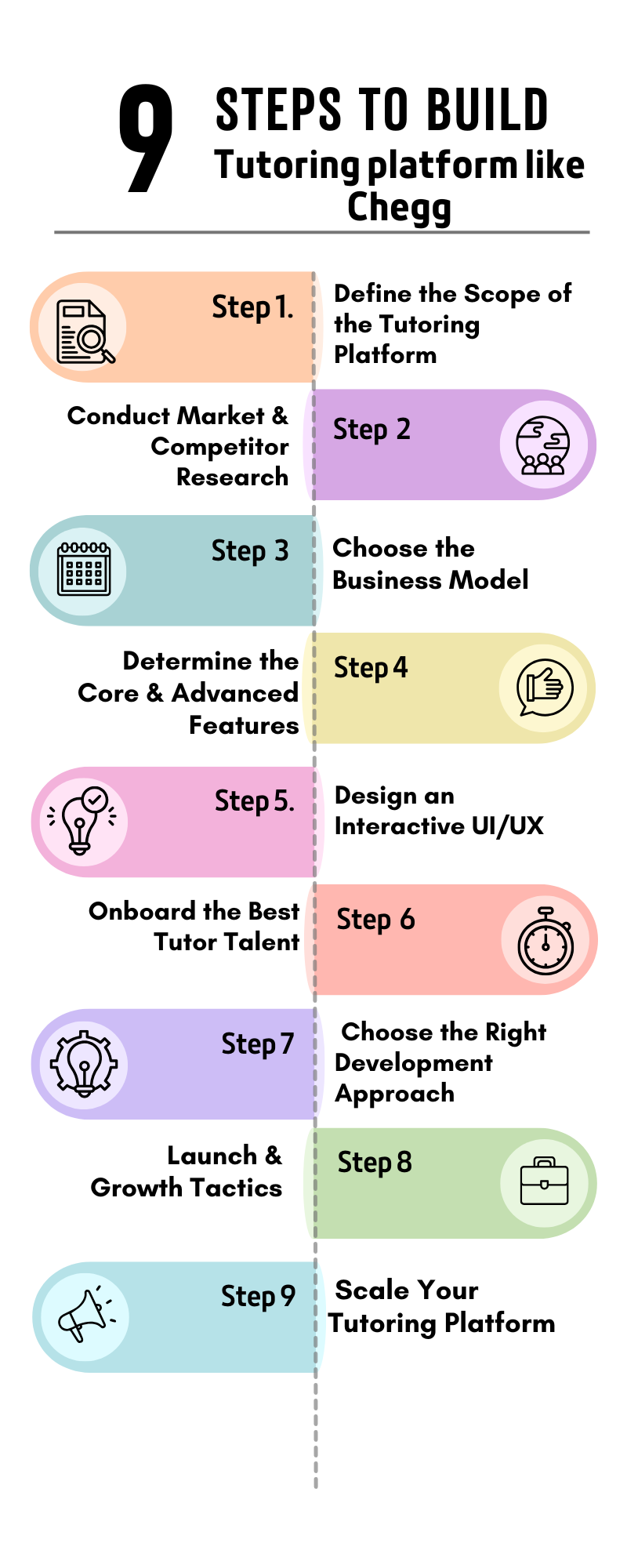
Step # 1: Define the Scope of the Tutoring Platform
First off, you need to decide the scope and tutoring ecosystem of your platform. What are the levels of tutoring you are planning to offer? Who is your target audience(e.g., school students, college or professional learners)? Does your platform offer tutoring help for STEM subjects, test preparation, or languages?
Laying the scope builds a solid foundation for your tutoring platform. Thus, you can seamlessly navigate through the next developmental phases.
Key Questions for Scope:
- What is your core business model?
- Who is your primary target audience?
- What learning modes are you supporting? (1:1, group, hybrid, on-demand Q&A)
- Are the sessions scheduled or on-demand?
- What is your MVP scope? (essential or advanced features)
Step # 2: Conduct Market & Competitor Research
Once you determine the scope of your audience, understand the market nuances before starting development. Identify gaps, audience’s pain points, and your competitor’s strengths and shortcomings.
Here’s a structured step-by-step market research plan:
-
Research Target Audience
Understand the needs, pain points, user behaviour, and demographics of your target market. Create detailed buyer personas with age, grade level, subjects, and study patterns. Remember, your target audience isn’t just students but includes parents and tutors as well. Use surveys, interviews, and polls as research tools.
-
Study Competitors
Identify the direct and indirect competitors for your tutoring platform. Chegg, Wyzant, Tutor.com, and Varsity Tutors are the top competitors. Look into the subjects, features, pricing, and revenue streams for each competitor.
-
Trends & Opportunities
Analyze the relevant market trends, such as AI, subscription-based tutoring, and mobile apps. Use tools like Google Search Trends, BuzzSumo, and Semrush to identify top trends and their search volume. Additionally, Reddit and Quora are top places to tap into discussions and trends.

Step # 3: Choose the Business Model
So far, we have determined the platform scope, market dynamics, and competitive landscape. It’s about time to understand the financial aspect, more specifically, how your platform drives revenue.
Determine the key revenue streams to keep your platform up and running. Chegg adopts a hybrid approach — a mix of on-demand tutoring, subscription model, and commissions. And we have already discussed how Chegg makes money above!
Key Monetization Streams for Tutoring Platform:
- Pay-per-service
Tutoring platform charges students hourly for live sessions, homework help, or other educational services.
- Subscription Model
Students get unlimited platform access with packages that charge a recurring fee. For example, Chegg Study pack includes study solutions, step-by–step support, and value-added services.
- Commission-Based Model
Earn a commission fee on tutoring sessions booked by students. Typically, tutoring platforms charge a 20%-30% commission fee on tutoring sessions. The commission depends on the type of tutoring, such as live sessions or on-demand help.
- Advertising & Partnerships
Beyond the core tutoring and homework help, platforms can make money from dedicated ad zones within the website. Think about tutoring, test preparation, and related educational brands. Collaborate with universities, colleges, and publishers to enhance educational offerings.
Step # 4: Determine the Features to Build a Tutoring Platform Like Chegg
Planning to develop a full-fledged tutoring platform like Chegg? You need to identify all the core features & functionalities and also blend in a unique proposition to stand out.
Let’s look into the must-have features for admin, tutor, and students!
Key Features for Students:
- User registration and login
Allow students to log in using email, phone or social login. Ensure they can create profiles with essential details, grades, subjects, and learning preferences.
- Search & filtering
An easy search tool makes tutor search and finding learning resources convenient. Design an easy and intuitive search with filters for subjects, topics, class, pricing, tutors, etc. Advanced search options include image upload, question search, math mode, etc.
- Live tutoring
Live tutoring sessions offer personalized support for a specific topic. Include audio and video call integration, whiteboard, file sharing and session recording for an interactive learning environment.
- Homework help and Q&A feature
Provide dedicated spaces where students can upload questions and get quick explanations or answers from experts.

- Textbook & study Resources
Tutoring platforms like Chegg started by offering textbook rentals and evolved into a full-fledged tutoring platform. Partner with leading third-party publishing platforms like Valore to provide affordable textbook rental access.
- Personalized study tools
Provide personalized study features like flashcards, practice sets, and step-by-step solutions for comprehensive learning.
- Payment access
Offer secure and convenient payments for on-demand tutoring, subscription, and wallet. Stripe and PayPal are popular payment gateways for tutoring platforms.
- Subscription Offerings
Students can avail a premium subscription to get step-by-step solutions, expert answers, flashcards, and practice tests for a specific topic. Additionally, you can integrate value-added services, personalized learning paths, or tools in the package.
- Communication
Integrate in-platform chat, video conferencing, notifications and reminders for enhanced student-tutor communication.
- Ratings & Reviews
Students can rate tutors for live sessions or expert answers. Further, students can mark answers helpful or not helpful depending on the quality of the answers.
- Progress Tracking
Progress tracking helps students to continue learning where they left off. Chegg doesn’t include full progress tracking, but provides stats like subjects accessed, correct questions answered, and progress activity.
Key Features for Tutors:
- Sign Up & Profile Creation
Create an easy sign-up and profile creation for tutors. Allow tutors to build a comprehensive profile summing up their expertise, qualifications, and achievements.
- Onboarding & Verification
To hire top talent for your tutoring platform, define eligibility criteria and a robust selection process. Include subject-wise proficiency tests and background checks to hire the best talent.
- Session Handling
Tutors can accept or reject tutoring sessions based on their availability. Implement security and authentication practices to avoid unauthorized access.
- Initiating Payouts
Tutors can initiate payout requests based on completed sessions and answers published. Plan either weekly, bi-weekly, or monthly payouts for tutors. Typically, PayPal is a preferred payment method for timely and secure payouts.
- Earnings Dashboard
Tutors can track their earnings and commission cut for diverse offerings through a dashboard.
Key Features for Admin:
- Dashboard & Analytics
Admin can analyze revenue and commission breakdown, bookings and business performance through reports & advanced analytics. This helps to track key metrics like churn, retention, learner progress, etc.
- Student & Tutor Management
Knowing the number of active students & tutors is essential for performance optimization. If more students are accessing the homework help solution, it implies the feature resonates well with students.
- Content Management
Admin must manage and moderate the content quality to put forth the best learning experience. Employ a mix of human and machine moderation in case of extensive content libraries.
- Payment Integration
Integrate with popular payment gateways like Stripe and PayPal for a seamless payment experience. Support major cards, wallets and local payment methods for hassle-free platform transactions.
- Platform Settings
Online learning platforms barely function as stand-alone entities. Third-party integrations, such as payment gateways, video conferencing, and email marketing software, are needed to set up the complete learning environment.
Step # 5: Design an Interactive UI/UX of the Tutoring Platform
While you focus on building an enriching feature-set, don’t compromise on user experience. An easy, intuitive and user-friendly interface is no longer a choice, rather a necessity.
Most learners perceive your platform visually first, before moving on to the functional experience. A seamless platform experience guides users, reduces friction, and improves conversions.
Key Elements of Building an Interactive UI/UX:
- Clear and Structured Navigation & Drop-Downs
- User-centered design with minimal learning curve
- Visually-appealing, yet simple colors & layouts
- Mobile-Optimized Interface
- Clear labels, actionable CTAs, and concise error messages
Chegg offers a clean and simple user interface with minimal color usage (orange & white). The top navigation is simple and covers the key interactions – study, homework help, expert Q&A and other tools, sign in, etc.
There’s a simple search where students can find topics for learning. The website is optimized for mobiles and smaller screens for learning from anywhere.
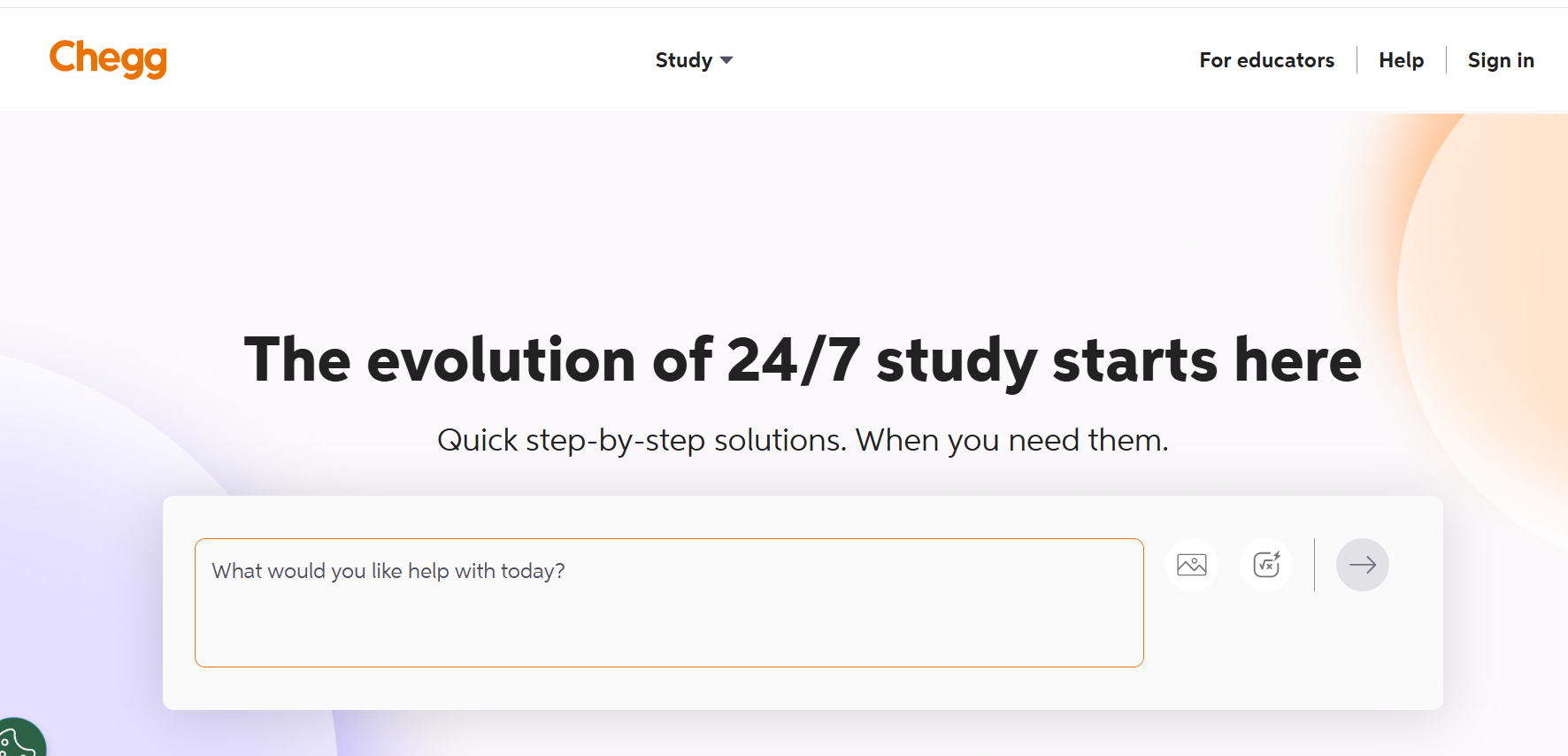
Step # 6: Choose the Right Development Approach
To metamorphose your business plan and design into reality, you need the right solution. This essentially reduces the cost and timeline to build your platform. While there are many solutions to scale your tutoring business, choose one that fits your business needs.
Here are the best development approaches to create a Chegg-like platform:
Ready-made Chegg Clone Scripts like Pinlearn
The best and simplest approach is to use highly customizable Chegg clone scripts like Pinlearn, dedicated to building such tutoring platforms. These solutions come integrated with core features, such as expert live sessions, Q&A, subscription models, and content library tools.
Pros:
- Pre-built scripts with essential features and functionalities
- Cost-effective solution with no hidden or recurring costs
- Highly-customizable white-label scripts
- Skip coding and long developmental cycles
- Integrated development and customization cycles to launch in weeks
No-Code platforms
Pre-built marketplace scripts like Bubble.io help in building an MVP and quickly launch your platform. While seamless launch and affordable cost are advantages, it lacks customisation & scalability.
Pros
- Build MVP with core features & functionalities
- No coding & design hassles
- Cost-effective & quick launch
Custom Development
The last and most expensive approach is to build the entire platform from scratch. This approach is suitable for building a platform with extensive customization or specialized tutoring needs. On the downside, you have to take complete ownership of development from planning to testing. However, high budget, extensive timeline and technical expertise make it less feasible for first-timers.
Pros:
- Highly-customizable
- Full ownership & branding control
- Scalable
- Perfect for integrating with an existing tutoring platform
Step # 7: Onboard the Best Tutor Talent
To build a successful online tutoring platform, you need a powerhouse of talent. By hiring experts for specific subjects, students are assured to get the right answers, comprehensive step-by-step solutions and overall the best guidance.
Here are effective strategies to hire the best tutors:
- Establish an eligibility criterion with qualifications, experience, and teaching skills
- Conduct interviews and subject-specific assessments to test tutoring skills & proficiency
- Define a robust and fair review process that aligns with your business goals
- Include background and verification checks to validate the information
- Partner with universities and educational institutions to onboard the best talent
- Offer competitive pay and performance-based incentives
💡 Tip: Include trial periods where you assess tutor performance for fixed sessions. You can even take feedback from students on key learning metrics.
⚡ Related: How to Attract Top Tutors to Your Platform?
Step # 8: Launch & Growth Tactics
Now that you have built the platform and onboarded the right tutors, it’s time to launch! Before you go live and offer extensive sessions and Q&A, launch a beta version!
Here are the key phases of the tutoring platform launch:
Pre-Launch & Testing Phase
- Release your tutoring platform for a limited group of audience to identify bugs, vulnerabilities, and gather real-time user feedback. Invite some credible tutors and early students to test your platform.
- Re-test all the essential features & monitor usage by beta users
- Create teasers and marketing campaigns to build hype
- Ask for short reviews and video testimonials from your beta users
- Prepare landing page & email sequences for the launch
Launch Phase
- Announce “the platform is live” officially on the website and emails
- Share the launch update on social media with key hashtags
- Encourage sign-ups with incentives and early-bird offers
- Track performance, UX experience, and feature functionality
Post-Launch Phase
- Gather early feedback from users (tutors & students) and improve the platform experience
- Leverage organic growth strategies like educational blogs, sharing valuable insights and tips on social media, how-to videos and tutorials
- Run paid ads on Google, LinkedIn and Meta to broaden your reach
- Create a referral program for tutors and students with attractive incentives
- Implement SEO strategies and optimize for high-volume keywords, such as “best online tutoring platform”, “1-to-1 online tutoring”,etc.
Step # 9: Scale Your Tutoring Platform
Scaling and growth are often subjective terms. Hence, you need to define what scaling means to you before expanding your business. Are you planning to intake more students & tutors? Do you want to expand your tutoring business across specific countries and regions? Thinking about automation or strategic partnerships?
Key Strategies to Scale Your Revenue & Offerings:
- Expand your offerings: Group tutoring, 1-on-1 live sessions, course libraries
- AI Tutor Assistant: Offer AI tutor guidance for homework help, instant solutions, summaries and follow-up questions
- Region-specific expansion: Expand your user base and subjects across countries and regions
- Partnerships & collaborations: Strategic partnerships with schools and top universities for discounted access, supplemental learning, and institutional programs
- Automation & Technological Enhancements: Integrate 24/7 chatbots for customer support, booking sessions, and personalized help
What is the Technology Stack for Building a Tutoring Platform Like Chegg?
Here’s the recommended tech stack to develop a tutoring platform like Chegg:
| Platform Aspect | Technologies |
| Front-End | Frameworks: React.js, Next.js
Mobile: Java, Swift/Kotlin, Flutter, Android Toolkit UI Libraries: Tailwind CSS, Ant Design |
| Back-End | Programming Languages: Node.js, Python, Ruby on Rails |
| Databases | PostgreSQL, MySQL, MongoDB |
| Payment Gateway Integration | Stripe, PayPal, BrainTree |
| Video & Live Streaming | Zoom, Agora, Google Meet, Teams |
| Push Notification | Firebase Cloud Messaging |
| Video Hosting | Vimeo, Wistia, AWS, JW Player |
| Analytics | Google Analytics, Mixpanel |
| Mailing Services | Sendgrid, ZeroBounce, Twilio, Mailgun |
Well, that was our step-by-step guide on how to create a tutoring platform like Chegg! You can create a customized plan as per your business goals and needs.
Conclusion
Developing an online tutoring like Chegg is a great way to step into the educational industry. While you give wings to your profitable pursuits, finding your competitive edge is crucial. There are many similar platforms like Quizlet, Course Hero, and Bartleby in this space. So, plan strategically and identify your USP to attract users and excel in your business.
Whether you’re planning a tutoring platform for test preparation or a hybrid one, it’s crucial to choose the right solution with core functionalities. Pinlearn is one of the best Chegg clone scripts with all core functionalities. Most importantly, you can launch the platform & start earning from it within weeks! Let’s connect on a 15-minute call to assess your needs and set a business roadmap!
FAQ-Related to How to Create a Tutoring Platform Like Chegg
1. How to make a website like Chegg?
The following are the key steps to create an online tutor platform like Chegg Tutors:
- Define the scope of your platform
- Perform Market Research & Competitive Analysis
- Choose the right business model
- Determine the essential and advanced platform features
- Choose the right development approach
- Onboard the best tutor talent
- Launch & growth tactics
- Scale your tutoring platform
2. Is there any other platform like Chegg?
Bartleby, Course Hero, and Quizlet are popular study & homework help solutions. On the other hand, Wyzant, Tutor.com, and Varsity Tutors are leading tutoring marketplaces.
3. How does Chegg make money?
Chegg adopts a hybrid business model that combines a strategic blend of on-demand, subscription, and value-added services.
Here are Chegg’s key revenue drivers:
- Chegg Study (Subscription plan)
- Chegg Tutors (On-Demand Services)
- Textbook Rentals & Learning Resources
- Chegg Writing & Math Solver
- Commissions from tutoring sessions
- Value-added services like plagiarism detector, citation generator, etc

